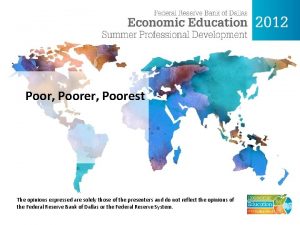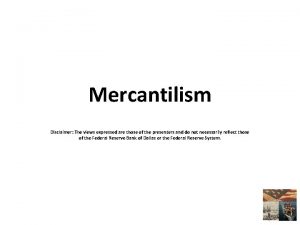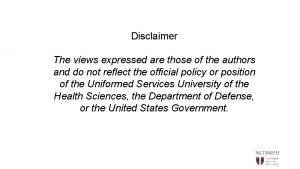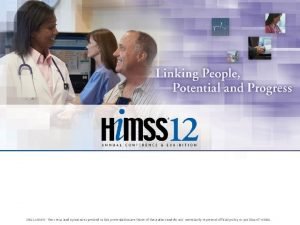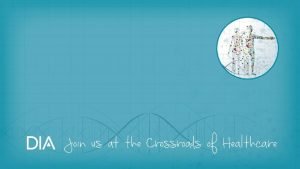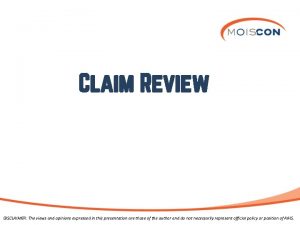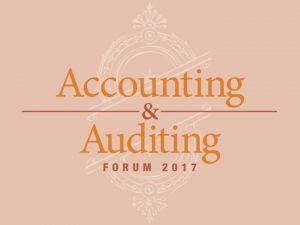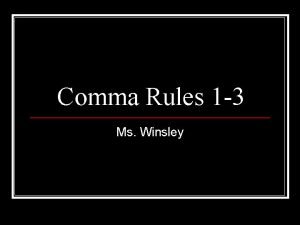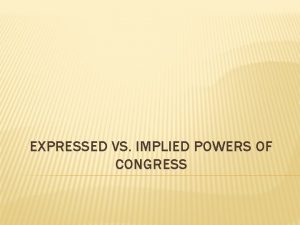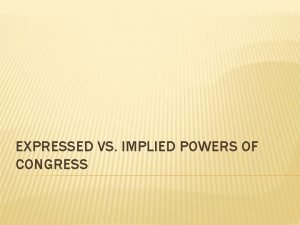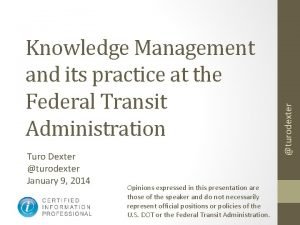Please note Any opinions expressed in this presentation


















- Slides: 18

Please note: Any opinions expressed in this presentation are those of the presenter and are not endorsed by the North Carolina Department of Justice 2015 -2016 AMENDMENTS TO THE SPCA This presentation has not been approved in accordance with the Attorney General’s policy for issuing formal opinions. Any opinions expressed in this presentation are those of the presenter and are not endorsed by the North Carolina Department of Justice.

2014 Amendments: Where are they now? H 74� Periodic review of rules � Gravel: SL 2015 -149 “a surface of number 57 stone, as designated by the American Society for Testing and Materials, laid at least four inches thick over a geotextile fabric; or a trail as defined in G. S. 113 A-85 that is either unpaved or paved as long as the pavement is porous with a hydraulic conductivity greater than 0. 001 centimeters per second (1. 41 inches per hour). "

2015 changes to SPCA Limitations on civil penalties � $5, 000 maximum/violation � Each day of continuing violation constitutes a separate violation H 97 Section 14. 26 (Appropriations Act) 2015 cap � No previous civil penalties � Abate within 180 days of NOV � Maximum cumulative penalty is $25, 000. 00 � Hand-delivery of NOVs

SCC remission prior to 2015 Remissions � Prior to 2015


Remissions H 97 Section 14. 26 “A request for remission of a civil penalty imposed under G. S. 113 A-64 may be filed with the Commission within 60 days of receipt of the notice of assessment. ” Quasi-judicial in nature � Decided only upon the record in front of the Commission � Oral argument: potential for unauthorized practice of law At party’s request If not requested, to be decided on the documents provided

WAIVED

CMS Waiver

SCC Waiver G. S. 113 A-64. 2(a) requires party to waive right to a contested case

Remissions package Submitted by assessed party � Waiver and stipulation of facts � Justification for remission request From DEMLR/Local program � Civil Penalty Assessment worksheet � Notice(s) of Violation/Continuing Violation � Civil Penalty Assessment � Green cards � Inspection report(s) � Staff recommendation


2016 Appropriations (SL 201694) DEVELOPMENT OF NEW COMPREHENSIVE NUTRIENT MANAGEMENT REGULATORY FRAMEWORK SECTION 14. 13. (a) The General Assembly finds all of the following: (1) It is necessary for the State to have a comprehensive management strategy to protect and improve water quality. (2) Over the last 20 years, comprehensive watershed nutrient management strategies and buffer rules have been implemented in several river basins and watersheds in North Carolina where surface water quality has been impaired by excess nutrients. (3) It is in the interest of the State to review the costs and benefits of existing nutrient management strategies and determine whether those nutrient management strategies should be modified in order to maintain and improve water quality in nutrient sensitive waters. (4) The State should revise nutrient strategies to maintain proven measures already shown to be effective; incorporate new technological and management innovations; recognize investments in water quality already implemented by stakeholders; and share costs on an equitable basis. SECTION 14. 13. (b) Subsections (a) and (c) of Section 14. 5 of S. L. 2015 -241 are repealed and the Department shall terminate the demonstration project authorized by that section. Any funds allocated under subsection (a) of Section 14. 5 of S. L. 2015 -241 that are unspent and unencumbered on the effective date of this act shall revert to the Clean Water Management Trust Fund. SECTION 14. 13. (c) Of the funds appropriated to the Board of Governors of The University of North Carolina, the sum of five hundred thousand dollars ($500, 000) for each of the fiscal years from 2016 -2017 through 2021 -2022 is allocated to the Chief Sustainability Officer at the University of North Carolina at Chapel Hill to designate an entity to oversee a continuing study and analysis of nutrient management strategies (including in situ strategies) and compilation of existing water quality data specifically in the context of Jordan Lake and Falls Lake. As part of this study, the entity shall (i) review data collected by the Department of Environmental Quality and by other stakeholders from water sampling in areas subject to the Falls Lake or Jordan Lake Water Supply Nutrient Strategies and compare trends in water quality to the implementation of the various elements of each of the Strategies and (ii) examine the costs and benefits of basinwide nutrient strategies in other states and the impact (or lack of impact) those strategies have had on water quality. The entity shall report to the Environmental Review Commission, the Environmental Management Commission, and the Department of Environmental Quality as set forth below: (1) With respect to Jordan Lake, the final results of its study and recommendations for further action (including any statutory or regulatory Page 122 Session Law 201694 House Bill 1030 changes necessary to implement the recommendations) no later than December 31, 2018, with interim updates no later than December 31, 2016, and December 31, 2017. (2) With respect to Falls Lake, the final results of its study and recommendations for further action (including any statutory or regulatory changes necessary to implement the recommendations) no later than December 31, 2021, with interim updates no later than December 31, 2019, and December 31, 2020. No indirect or facilities and administrative costs shall be charged by the University against the funds allocated by this section. The Department of Environmental Quality shall provide all necessary data and staff assistance as requested by the entity for the duration of the study required by this subsection. The Department shall also designate from existing positions an employee to serve as liaison between the Department and the entity to facilitate communication and handle data requests for the duration of the project. SECTION 14. 13. (d) As part of the periodic review and readoption of rules required by G. S. 150 B-21. 3 A, the Environmental Management Commission shall, based on the study required by subsection (c) of this section and any monitoring or modeling study conducted pursuant to existing regulations as defined in this section, review the following Nutrient Strategies: (1) The Falls Water Supply Nutrient Strategy, 15 A NCAC 2 B. 0275 through. 0282 and. 0315. (2) The Jordan Lake Water Supply Nutrient Strategy, 15 A NCAC 2 B. 0263 through. 0273 and. 0311. (3) Any changes to these regulations imposed by acts of the General Assembly. The schedule set forth in this subsection shall modify the review and readoption schedule set by the Rules Review Commission under G. S. 150 B-21. 3 A to the extent the schedules conflict. No later than December 31, 2016, the Department of Environmental Quality shall report to the Environmental Review Commission a list of any other rules and any acts of the General Assembly changing the rules identified in this subsection, and the Environmental Management Commission's review shall include the rules identified in this section and in that report. As part of its rule review process, the Environmental Management Commission shall (i) hold public hearings in the upstream and downstream portions of the Falls Lake and Jordan Lake river basins and subbasins and (ii) no later than December 31, 2016, convene a stakeholder working group that represents all classes of users and all geographic parts of the impacted river basins and subbasins and that will provide input to the Environmental Management Commission regarding the revision to the Nutrient Strategies. The Environmental Management Commission shall issue recommendations for revisions of the Nutrient Strategies based on its review and begin rule readoption required by G. S. 150 B-21. 3 A no later than March 15, 2019. For purposes of the G. S. 150 B-21. 3 A readoption process, the Nutrient Strategies shall be considered "necessary with substantive public interest. " SECTION 14. 13. (e) The Department of Environmental Quality shall study alternative technologies for in situ approaches to nutrient management in Falls Lake and Jordan Lake. In its study, the Department shall consider in situ treatments, including algaecide and phosphorus-locking technologies, that have been certified by the United States Environmental Protection Agency for use in drinking water sources. Of the funds appropriated in this act to the Department of Environmental Quality, the sum of one million three hundred thousand dollars ($1, 300, 000) for the 2016 -2017 fiscal year may be used to implement a trial of these technologies. If the Department decides to implement a trial, it shall enter into a contract for the trial by December 31, 2016. Any contract entered into under this subsection shall not be subject to Article 3 or Article 8 of Chapter 143 of the General Statutes. The study shall determine whether these treatments would provide improvements in water quality and whether the improvements would be more cost-effective than more conventional nutrient mitigation strategies. The Department shall submit an interim report no later than March 1, 2017, and a final report no later than March 1, 2018, to the Environmental Review Commission, the Joint Legislative Oversight Committee on Agriculture and Natural and Economic Resources, and the Fiscal Research Division. If the Department finds these strategies to be effective, it shall incorporate them into the Nutrient Strategies readoption required by subsection (d) of this section. Funds allocated by this subsection shall remain available until the conclusion of the study, and any funds unused at that time shall revert to the General Fund. House Bill 1030 Session Law 2016 -94 Page 123 SECTION 14. 13. (f) Impervious surface added in a city or county within the Jordan Lake watershed after July 26, 2013, and prior to December 31, 2020, shall, notwithstanding any other provision of law or associated regulations adopted by the Environmental Management Commission, not be counted as built-upon area for purposes of a city's or county's calculation of nutrient loading targets under a Development Stormwater Rule. Pursuant to G. S. 153 A-145. 6 and G. S. 160 A-205. 1, cities and counties shall not enforce Development Stormwater Rules through any ordinance, code, standard, committed element, condition, or contractual obligation imposed by, agreed upon, or accepted by a county or city. For purposes of this subdivision, "Development Stormwater Rule" shall mean 15 A NCAC 2 B. 0265 (Stormwater Management for New Development) and 15 A NCAC 2 B. 0266 (Stormwater Management for Existing Development), or equivalent or more stringent ordinance, code, standard, or committed element related to nutrient-loading targets in the Jordan Lake watershed. SECTION 14. 13. (g) The Department of Environmental Quality shall study the following issues related to nutrient impact fees and other water quality impact mitigation programs in Jordan Lake and Falls Lake: (1) The impact, costs, and benefits of setting nutrient offset fees on a subbasin- or area-specific basis, together with an estimate of the subbasin-specific nutrient offset fees for each subbasin in the Jordan Lake and Falls Lake watersheds or area draining to a particular arm of Jordan Lake or Falls Lake. (2) Watersheds and river basins or subbasins where private providers of mitigation services are adequately serving existing and projected demand over the next five years, and whether (i) the continuing provision of mitigation services by the State in those areas is necessary and (ii) statutory authority to provide mitigation services in those areas should be totally or partially repealed. The Department shall report no later than December 1, 2016, to the Environmental Review Commission, the Joint Legislative Oversight Committee on Agriculture and Natural and Economic Resources, and the Fiscal Research Division regarding the results and recommendations from its study and any suggested legislation necessary to implement the recommendations. SECTION 14. 13. (h) The rules described below shall not take effect and are subject to the review and readoption required by subsection (d) of this section: (1) With respect to the Jordan Lake rules, as defined by subdivisions (2) and (3) of subsection (d) of this section, any rules with effective dates between the effective date of this act and October 15, 2019. (2) With respect to the Falls Lake rules, as defined by subdivisions (1) and (3) of subsection (d) of this section, any rules with effective dates between the effective date of this act and October 15, 2022. SECTION 14. 13. (i) Stormwater treatment practices that have been approved by the Chesapeake Bay Commission for TMDL compliance in the Chesapeake Bay watershed shall be allowed for TMDL compliance in the Jordan Lake and Falls Lake watersheds at the same pollutant removal efficiency value established for each such practice for the Chesapeake Bay watershed. The Department shall report no later than December 1, 2016, to the Environmental Review Commission, the Joint Legislative Oversight Committee on Agriculture and Natural and Economic Resources, and the Fiscal Research Division on the need and desirability of establishing Statespecific pollutant removal efficiency values for the stormwater treatment practices allowed by this subsection. If the Department decides to establish State-specific values, it shall incorporate those values into the Nutrient Strategies readoption required by subsection (d) of this section. SECTION 14. 13. (j) Subsection (b) of this section becomes effective on the earlier of July 1, 2016, or

Highlights- SL 2016 -94 Section 14. 13 $500, 00 to do cost/benefit analysis on nutrient management strategies Based on that study, EMC must review Jordan/Falls Lake Nutrient Strategy rules, begin readpotion by March 15, 2019 $1. 3 Million to DEQ to study in water treatment Delay effectiveness of Jordan Lake rules to 2019 Delay effectiveness of Falls Lake rules to 2022

Jordan/Falls Lake Rules SL 201694 Impervious surface added in a city or county within the Jordan Lake watershed after July 26, 2013, and prior to December 31, 2020, shall, . . . not be counted as built-upon area for purposes of a city's or county's calculation of nutrient loading targets under a Development Stormwater Rule. Cities and counties shall not enforce Development Stormwater Rules through any ordinance, code, standard, committed element, condition, or contractual obligation imposed by, agreed upon, or accepted by a county or city. "Development Stormwater Rule" shall mean 15 A NCAC 2 B. 0265 (Stormwater Management for New Development) and 15 A NCAC 2 B. 0266 (Stormwater Management for Existing Development), or equivalent or more stringent ordinance, code, standard, or committed element related to nutrientloading targets in the Jordan Lake watershed.

S 160 (SL 2016 -33) Warsaw Veterans Day Parade � Oldest continuously held Veterans Day Parade in the Country

2017 -2018 Session Began on January 11 As of 3/27: � 481 Bills filed in House � 389 Bills filed in Senate (SB 303 - expand prohibition of driving under the speed limit in the left lane) � H 74/S 197 - Bobcat as State cat � H 96 Fayetteville State Fried Chicken Festival � S 142 State Spider- Linville Caverns spider � S 348 Bobwhite quail as State gamebird


NC Farm Act 2016 S 770 SL 2016 -113 Section 14 This Article shall not apply to the following landdisturbing activities: (1) Activities, including the breeding and grazing of livestock, production and activities relating or incidental to the production of crops, grains, fruits, vegetables, ornamental and flowering plants, dairy, livestock, poultry, and all other forms of agriculture undertaken on agricultural land for the production of plants and animals useful to man, including, but not limited to: g. Mulch, ornamental plants, and other horticultural products. For purposes of this section, "mulch" means substances composed primarily of plant remains or mixtures of such substances.
 The views and opinions expressed
The views and opinions expressed All opinions expressed disclaimer
All opinions expressed disclaimer The views expressed
The views expressed Views and opinions disclaimer
Views and opinions disclaimer The opinions expressed disclaimer
The opinions expressed disclaimer The views and opinions expressed disclaimer abs-cbn
The views and opinions expressed disclaimer abs-cbn Disclaimer the opinions expressed
Disclaimer the opinions expressed Disclaimer
Disclaimer Irrational numbers
Irrational numbers Raymond carver will you please be quiet please
Raymond carver will you please be quiet please Please note comma
Please note comma Difference between note making and note taking
Difference between note making and note taking Word signal
Word signal Difference between note making and note taking
Difference between note making and note taking Financial documents order
Financial documents order Debit note example
Debit note example What is a debit memo
What is a debit memo Note making advantages
Note making advantages Simple discount note
Simple discount note
